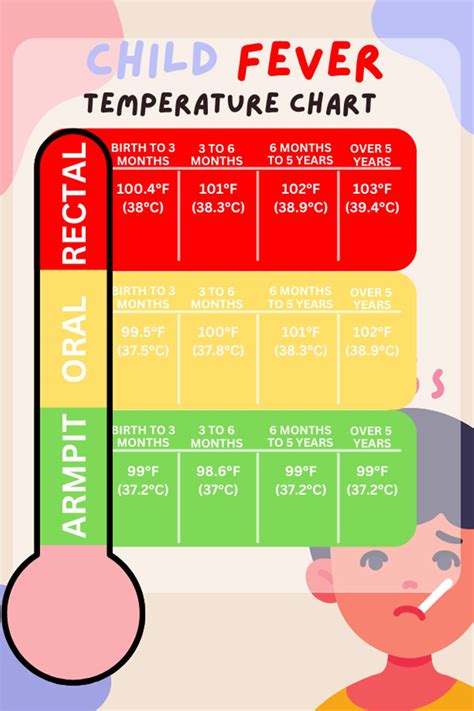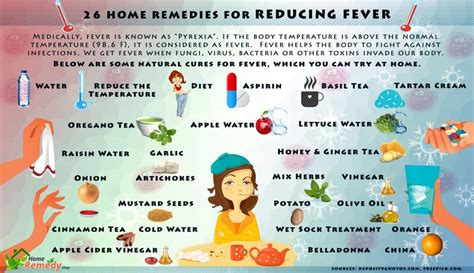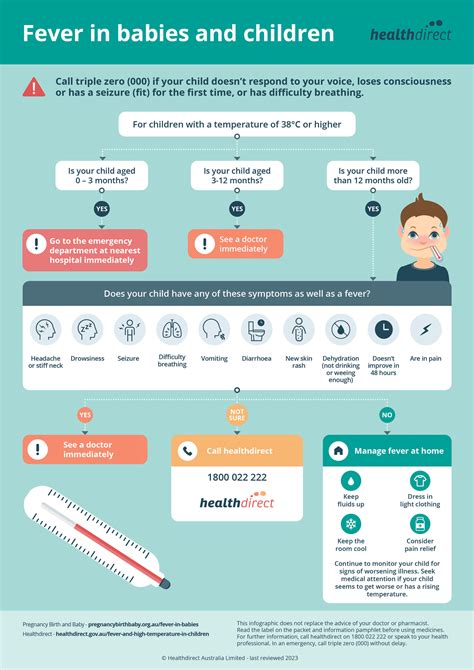Intro
Check normal fever temperature in Celsius, understand fever ranges, and learn to manage high body temperature with our guide, covering low-grade to severe fever symptoms and treatment options.
Normal body temperature is around 37 degrees Celsius, but it can vary slightly from person to person. Fever, also known as pyrexia, is a temporary increase in body temperature, usually above 37.5 degrees Celsius. It is a common symptom of many illnesses, including infections, and can be caused by a variety of factors, such as viruses, bacteria, or other pathogens. In this article, we will delve into the world of fever temperature in Celsius, exploring its causes, symptoms, and treatment options.
Fever is a natural response of the body's immune system to infection or inflammation. When the body detects the presence of a foreign invader, it releases chemicals that trigger a rise in body temperature. This increased temperature helps to create an environment that is less conducive to the growth and reproduction of the invading pathogens. In most cases, fever is a self-limiting condition, meaning it will resolve on its own once the underlying infection or illness has been treated. However, in some cases, fever can be a sign of a more serious condition, such as sepsis or meningitis, which requires prompt medical attention.
The severity of fever can vary greatly, ranging from a mild, low-grade fever to a severe, high-grade fever. Low-grade fever is typically defined as a body temperature between 37.5 and 38.3 degrees Celsius, while high-grade fever is defined as a body temperature above 39.4 degrees Celsius. In general, the higher the fever, the more severe the underlying illness is likely to be. However, it's essential to note that some people may experience more severe symptoms at lower temperatures, while others may be more resilient to higher temperatures.
Understanding Fever Temperature

To understand fever temperature, it's crucial to recognize the different types of fever and their corresponding temperature ranges. There are several types of fever, including continuous fever, remittent fever, intermittent fever, and relapsing fever. Continuous fever is characterized by a persistent, elevated body temperature, usually above 38 degrees Celsius. Remittent fever is marked by daily fluctuations in body temperature, but the temperature remains above normal throughout the day. Intermittent fever involves periods of normal body temperature, punctuated by episodes of fever. Relapsing fever is characterized by recurring episodes of fever, often due to a recurring infection or illness.
Causes of Fever
Fever can be caused by a wide range of factors, including infections, inflammatory conditions, and environmental factors. Some common causes of fever include respiratory tract infections, such as pneumonia or bronchitis, urinary tract infections, and gastrointestinal infections, such as food poisoning or gastroenteritis. Other causes of fever include autoimmune disorders, such as rheumatoid arthritis or lupus, and certain types of cancer, such as lymphoma or leukemia.Symptoms of Fever

The symptoms of fever can vary depending on the underlying cause and the severity of the condition. Common symptoms of fever include headache, fatigue, muscle aches, and sweating. In some cases, fever can be accompanied by other symptoms, such as chills, nausea, or vomiting. In severe cases, fever can lead to more serious complications, such as seizures, confusion, or even organ failure.
Treatment Options for Fever
Treatment for fever depends on the underlying cause and the severity of the condition. In most cases, fever can be treated with over-the-counter medications, such as acetaminophen or ibuprofen, which can help to reduce the body temperature and alleviate symptoms. However, in some cases, prescription medications or hospitalization may be necessary to treat the underlying infection or illness.Home Remedies for Fever

There are several home remedies that can help to reduce fever and alleviate symptoms. Some of these remedies include staying hydrated by drinking plenty of fluids, such as water or electrolyte-rich beverages, resting and avoiding strenuous activities, and using a cool compress or cold pack to help bring down the body temperature. Other remedies include taking a lukewarm bath or shower, using a humidifier to add moisture to the air, and practicing relaxation techniques, such as deep breathing or meditation, to help reduce stress and promote relaxation.
When to Seek Medical Attention
While fever is a common symptom of many illnesses, there are certain situations in which medical attention is necessary. If you or someone you know is experiencing a high-grade fever, above 39.4 degrees Celsius, or if the fever is accompanied by other severe symptoms, such as difficulty breathing, chest pain, or severe headache, seek medical attention immediately. Additionally, if you have a weakened immune system or are taking immunosuppressive medications, it's essential to seek medical attention if you develop a fever.Prevention of Fever

Preventing fever involves taking steps to reduce the risk of infection and illness. Some of these steps include practicing good hygiene, such as washing your hands regularly, avoiding close contact with people who are sick, and getting vaccinated against common illnesses, such as influenza or pneumonia. Additionally, maintaining a healthy lifestyle, including eating a balanced diet, exercising regularly, and getting enough sleep, can help to boost the immune system and reduce the risk of illness.
Complications of Untreated Fever
Untreated fever can lead to serious complications, including organ damage, seizures, and even death. In severe cases, fever can cause the brain to become inflamed, leading to conditions such as encephalitis or meningitis. Additionally, untreated fever can lead to dehydration, which can cause serious complications, including kidney damage or heart problems.Fever in Children

Fever in children can be a concerning symptom for parents, but it's essential to remember that fever is a common symptom of many childhood illnesses. In most cases, fever in children can be treated with over-the-counter medications, such as acetaminophen or ibuprofen, and home remedies, such as staying hydrated and resting. However, if your child is experiencing a high-grade fever, above 39.4 degrees Celsius, or if the fever is accompanied by other severe symptoms, such as difficulty breathing or severe headache, seek medical attention immediately.
Fever in Older Adults
Fever in older adults can be a more serious symptom than in younger adults, as it can be a sign of a underlying illness or infection. Older adults may be more susceptible to fever due to age-related declines in immune function, and they may be more likely to experience serious complications, such as pneumonia or sepsis. If you or someone you know is an older adult experiencing fever, it's essential to seek medical attention promptly to rule out any underlying illnesses or infections.Fever and Pregnancy

Fever during pregnancy can be a concerning symptom, as it can be a sign of an underlying illness or infection. In most cases, fever during pregnancy can be treated with over-the-counter medications, such as acetaminophen, and home remedies, such as staying hydrated and resting. However, if you are experiencing a high-grade fever, above 39.4 degrees Celsius, or if the fever is accompanied by other severe symptoms, such as difficulty breathing or severe headache, seek medical attention immediately.
Fever and Travel
Traveling to new destinations can increase the risk of fever, as you may be exposed to new pathogens or illnesses. To reduce the risk of fever while traveling, it's essential to take steps to prevent illness, such as getting vaccinated against common illnesses, practicing good hygiene, and avoiding close contact with people who are sick. Additionally, maintaining a healthy lifestyle, including eating a balanced diet, exercising regularly, and getting enough sleep, can help to boost the immune system and reduce the risk of illness.What is a normal body temperature?
+A normal body temperature is around 37 degrees Celsius, but it can vary slightly from person to person.
What are the symptoms of fever?
+The symptoms of fever can include headache, fatigue, muscle aches, and sweating, as well as other symptoms such as chills, nausea, or vomiting.
How can I treat fever at home?
+Fever can be treated at home with over-the-counter medications, such as acetaminophen or ibuprofen, as well as home remedies, such as staying hydrated, resting, and using a cool compress or cold pack to help bring down the body temperature.
When should I seek medical attention for fever?
+You should seek medical attention for fever if you are experiencing a high-grade fever, above 39.4 degrees Celsius, or if the fever is accompanied by other severe symptoms, such as difficulty breathing, chest pain, or severe headache.
Can fever be prevented?
+Yes, fever can be prevented by taking steps to reduce the risk of infection and illness, such as practicing good hygiene, getting vaccinated against common illnesses, and maintaining a healthy lifestyle.
In final thoughts, fever temperature in Celsius is an essential topic that requires attention and understanding. By recognizing the causes, symptoms, and treatment options for fever, individuals can take steps to prevent and manage this common symptom. Whether you are experiencing fever yourself or are caring for a loved one, it's crucial to seek medical attention if you are unsure about the severity of the condition or if you are experiencing any severe symptoms. By working together, we can promote a healthier and more informed community, where individuals can take control of their health and well-being. We encourage you to share this article with others, and to comment below with any questions or concerns you may have. Together, let's work towards a healthier future, one conversation at a time.
